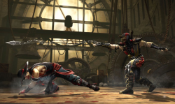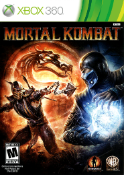Mortal Kombat Review
|
|
See PixlBit's Review Policies

On 11/11/2011 at 12:00 PM by Julian Titus Mortal Kombat is back, but should it have stayed in the 90s with C&C Music Factory and Crystal Pepsi? |

If you have fond memories of fatalities, Pits, and men who yell "Toasty!", you owe it to yourself to buy this game. Otherwise, this new Mortal Kombat probably won't convince you to choose it over more technical fighting games.
Who would have guessed that the 2009 release of Street Fighter IV would bring the fighting game scene of the 90s back with a vengeance? While the genre has never truly gone away, there was something about the release of Capcom’s fourth numbered entry in the SF series that seemed to remind gamers of all types that it’s fun to beat the crap out of your family and friends. Of course, a return to the fighting scene of the 90s also means a glut of also-rans showing up, and even though it might not be as crowded as it was in, say, 1994, separating the gems from the stinkers can be an issue. This is the challenge that Ed Boon faced as he released the 9th Mortal Kombat game onto consoles, but I can say with confidence that the new MK uppercuts the competition just as it did way back in 1992.

Don’t call it a Komeback, though. This is actually a reset for the series that takes into account everything that has gone before, all the way up to Mortal Kombat: Armageddon on the PS2 and Xbox. I’ve always liked the fact that the guys at Midway (now NetherRealm) tried to give the MK franchise some semblance of a story beyond the “get together at a tournament and fight it out” backstory that so many other fighting games settled for, and this iteration actually centers everything on its narrative. Shao Kahn has won, and Earth Realm belongs to him. Just before killing Raiden once and for all, the fallen thunder god sends a message back in time to himself during the tournament from MK1. With Raiden forewarned about the events of the Mortal Kombat games, he sets out to do things differently. This all plays out in Mortal Kombat’s Story Mode, which, believe it or not, is the true meat of this game.
That’s because such care has gone into this Story Mode that it completely makes up for that horrendous second film, as well as that ill-fated TV show from 1998. You’ll take control of different fighters as the story unfolds, starting with Johnny Cage. The game flows from pre-rendered cutscenes to actual combat almost seamlessly. The voice acting is pretty well done for the most part, and the dialogue straddles that fine line of awesome and cheesy that the MK series has managed to do from the outset. You’re not going to find anything Earth-shattering about the storyline here, but for a martial arts action romp it does its job and then some. If you’re a fan that actually knows how the original story unfolded you’re in for some shocking surprises here. Story Mode really fleshes out the single-player element of the game and will also give you a good grasp on the different fighters, so I suggest you jump into it right away.

Mortal Kombat is a bit of an odd package when it comes to the fighting mechanics. On one hand, this feels like a game designed to bring back old fans who remember “Get over here!” and ice balls, but ignored the series since parts 3 or 4. The button layout is different, and that was really throwing me off for the first few hours of the game. Gone are the high and low punches and kicks, replaced with front and back versions of the attacks, which correlate to your fighter’s stance. Many of the inputs have changed as well, so it wasn’t as easy to hop right back in as I thought it would be. But the additions to the core mechanics are welcome ones, thanks in no small part to the super meter. This breaks up into three stages: at the first stage, you can pull of enhanced versions of your special moves. Raiden, for example, can fire lightning bolts at your front and back, which can trip up opponents. At the halfway point, you can do a Killer Instinct-like Combo Breaker, and that is a great way to get out of the way of the final stage of the meter—the X-Ray Move. Think of the X-Ray as an Ultra Combo from Street Fighter IV; it does massive damage and can totally turn things around when used effectively, but it will drain your entire meter. These are also some of the most brutal moves in the game, and in some cases put the Fatalities to shame.
Mortal Kombat feels like Mortal Kombat, for better or worse. There’s always been a jerkiness to the game that has never been ironed out, and because of that, Mortal Kombat has never felt as precise or as good as a Street Fighter or SNK game to me. This Mortal Kombat is no different, and I was disappointed that the game didn’t feel snappier. Once I got the timing down I was just fine, but it’s the type of issue that has always kept this from being a game that I play for keeps, like Street Fighter. The combo system is robust, and the super meter adds some desperately needed strategy to the series, but it stops just short of being a revolution. If that doesn’t bother you, feel free to take your game online, thanks to a couple interesting match styles. You can do a tag team mode, ala the Capcom “vs.” games or Tekken Tag Tournament, and the innovative “King of the Hill” mode. This is basically like the Endless Battle room in SF IV, but with an awesome twist—your avatars are on screen as you watch the matches unfold. You can cheer or boo, and at the end of a match you can award points to the winner, almost like Olympic judging. It makes waiting your turn in line more fun, and brings back a little bit of that arcade trash-talking to the online landscape.

So, Mortal Kombat plays well and has a great selection of modes for both online and offline. Overall, this is a nice package. The problem with it is that there’s just not a lot that’s new here, and so many parts of the game seem stuck in a time warp. Let’s start with those character designs, shall we? Back in the 90s, John Tobias’s character designs were awesome, what with the ninjas and the four-armed monsters and the sexy ladies. But that was a long time ago, and things have changed. There were times when I was embarrassed to play this game. Looking at the absurd costume designs for Sonya and Mileena made me cringe, especially when they would get battle damage and somehow be less clothed than before. Characters like Baraka look absolutely ridiculous, especially when he attempts to move his mouth to talk in cutscenes, and Shao Kahn is wearing the same metal album cover reject outfit he’s always worn. It just feels like more of the same, and that isn’t helped by the fact that there are absolutely no new characters in this game. You’ll get a cyber version of a character, as well as human versions of Sektor and Cyrax, but they play the same as they always have. It’s a missed opportunity, and I really feel like these characters could use a makeover. And a breast reduction, in many cases.
Mortal Kombat is a great reimagining of the first three games, and a lot of the gameplay has been improved just enough to make it a contender for the more technical fighters out there. You will keep busy with the Story Mode and Challenge Tower, which contains 300 increasingly tougher trials to overcome. It just doesn’t go far enough to make the MK franchise feel modern and relevant, and unless you’re a hardcore Mortal Kombat fanatic, this probably won’t be a game you’ll be playing for the long haul.










Comments